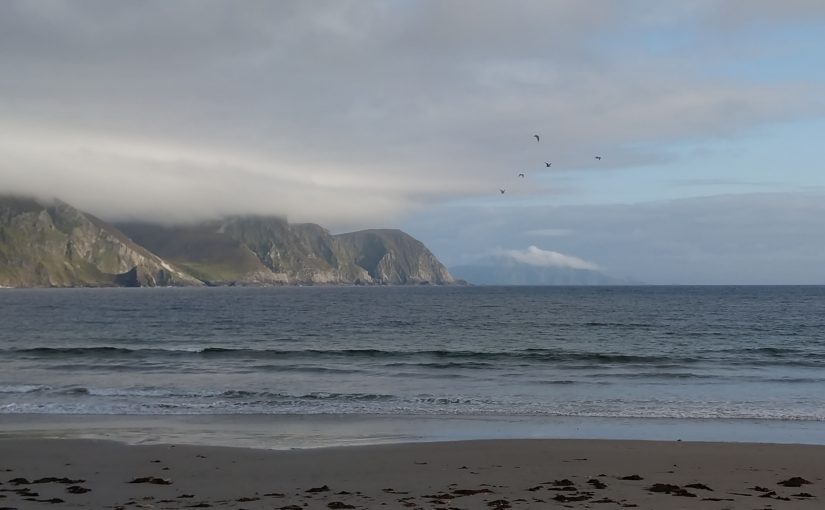After I finished working on the tune and story of Eleanor Plunkett, I picked up on a reference from Alasdair Codona’s writings. Alasdair had pointed out that tune no.94 titled “Kitty Magennis” in Donal O’Sullivan’ Carolan the Life Times and Music of an Irish Harper (1958) was actually another version of the tune of Eleanor Plunkett. I added a comment to my Eleanor Plunkett blog post to include a facsimile of O’Sullivan’s source and a typeset and mp3 version.
Continue reading A previously unpublished Carolan tune: Kitty MagennisTag: manuscript
Bradóg
We have two independent live transcription notations of this tune in Edward Bunting’s papers. In this post we will look at both of them in turn, and then we will discuss the likely provenance of each. We will also briefly consider other versions of the tune.
Continue reading BradógThe structure of MS4.29
The other day I was in Belfast, and I went to Queen’s University Belfast Special Collections to look at Manuscript 29, which contains Edward Bunting’s live transcription notations which he did in the 1790s, as well as tunes he copied from other books, and other jottings and rough notes. But instead of looking at the notations and writing, I spent my time peering at the ends of the book, looking at how the pages are fixed together.
Continue reading The structure of MS4.29An londubh agus an chéirseach
The Blackbird and the Thrush is a very beautiful old tune. We have what may be a live transcription of a traditional harp performance, noted down by Edward Bunting in the 1790s. However, as usual with Bunting’s work, all is not straightforward, and he has messed us around a lot.
Continue reading An londubh agus an chéirseachPlanxty Irwin
On the same manuscript page as The Beggar, Bunting also wrote what looks like a live transcription notation of the tune of Planxty Irwin (DOSC 59). You can see both of these tunes on Queen’s University Belfast, Special Collections, MS4.29 page 7.
Continue reading Planxty IrwinCasadh an tSúgáin
Edward Bunting made what looks to me like a live transcription notation of the tune of Casadh an tSúgáin, probably in Summer 1792. He writes 50 years later that he took this down from the harper Rose Mooney, but I don’t know if we can rely on his memory. Anyway, the transcription notation is very interesting and presents a very lovely version of the tune with a lot of what I assume is old Irish harp idiom and style in it.
Continue reading Casadh an tSúgáinIrish Harpers particularly from Belfast
File AI.80.019 in the NMI archive contains papers associated with a harp (NMI DF:1980.6) which is said to have originally belonged to Valentine Rainey, master of the Belfast Harp Society school in the early 19th century. The file includes letters relating to the purchase of the harp, as well as photocopies of a selection of other documents which may have come with the harp; there are some pages from Charlotte Milligan Fox’s book, Annals of the Irish harpers (1911), a photo of the harp with some information about its provenance, and a couple of handwritten pages of information about harpers.
There is no other information about these handwritten pages; all we have is the photocopies themselves. One is obviously a quick draft version, and the second a neater and slightly fuller version. The handwriting is difficult to read. This is my transcription of the two sheets.
Continue reading Irish Harpers particularly from BelfastTwo more mystery tunes
Bunting has written two tunes on Queen’s University Belfast, Special Collections, MS4.29 page 220/218/227/f108v. At first they seem clear, with clearly written titles. But I cannot find other versions of them, and I do not know if these are harp transcriptions, or fiddle or vocal performances that Bunting has transcribed.
Continue reading Two more mystery tunesThe Weaver’s Lamentation
Edward Bunting wrote a song with a full piano arrangement into one of his collecting pamphlets, probably in the summer of 1792. I was going to silently pass over these pages as part of my Old Irish Harp Transcriptions Project, but I thought that actually this is an interesting enough thing to do a post about it.
Continue reading The Weaver’s LamentationMailí Bhán
When I started playing the harp, I worked through Ann Heymann’s book Secrets of the Gaelic Harp (Clairseach, 1988). The first tune that I learned from this book was Mailí Bhán, “fair Molly”.
Continue reading Mailí Bhán








